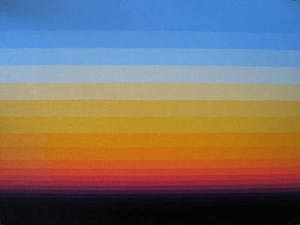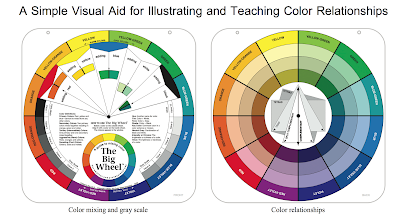I was fortunate to be able to attend pre-opening galas for the new Vladem Contemporary Museum show on Shadow and Light here in Santa Fe.
I am not including images of the show's works here. You may see samples of the artists' works here from other references.
“Shadow and Light explores in part how those new techniques allowed artists to interpret their emotional, psychological, or spiritual experiences of the Southwest,” Mark White, NMMOA executive director, said last summer.
I had a slightly different take on the exhibit; I noticed that "mathematics" was mentioned in the descriptions of the artwork a number of times ('geometry' occurs frequently also). This intrigued me (as a Mathematician, but also as an Artist).
Since light is in fact very mathematical perhaps it makes sense that we would find that the work in this exhibit referenced mathematics. I was just surprised - pleasantly surprised. And I decided to do a little research into a few of the exhibition's artists and their works.
Example 1. Artist, Norman Zammitt, showed a pattern of color bars with each one slightly different from the previous one. The work's description states: ".. he began assigning mathematical values to colors to create an effective transition between one color and the next." The Vladem work was created in 1975. Since that time we have all become familiar with patterns of color and their hexadecimal representations. I would like to know if this was well known 50 years ago. I would also like to know if the mathematical values he assigned to colors were the hexadecimal equivalents.
Norman Zammitt was raised on the Mohawk [Caughnawaga Indian] reservation near Montreal. After serving in the U.S. Air Force during the Korean War, he returned to America, graduated from Pasadena City College in 1957, and earned his MFA ('61) from Otis in 1961. He taught art at California Institute of the Arts, USC, and UCLA during his long career as an artist. ..
...
His often mural-sized works can now be found in private collections as well as at the Museum of Modern Art, the Hirschhorn Collection, and the Corcoran Gallery. His straight-edge style suggested mathematics and engineering, some reviewers observed; others posited that the ethereal element in his art seemed to rise up out of the geometry by intention. Often his work was said to create a “meditative mood.”
“Zammitt crafted meticulous bands of color in subtle gradations and shades in his paintings,” noted the Los Angeles Times. “Many of them evoke sunsets, deserts and other scenes in nature."
Sample of Zammitt's work (reminiscent of the work shown at the exhibit):
Example 2. And yet, another artist, August Muth, used the term geometric, in his holographic light etchings' description: "colorful geometric patterns".
August Muth (b 1955 , Albuquerque) :
http://www.augustmuth.com/:
Example 3: Charles Ross (b: 1937). https://www.charlesrossstudio.com/
In the exhibit, Ross' work's (3 Part Serial Cube Set) description states partially:
"... has explored scientific and mathematical principles as an expression of cosmic....".
This example included here is not like the work seen in the exhibit. I include the drawing here from his website since I enjoyed seeing the word, "symmetry", in it, a major component of my current shows. Also his bio states that he majored in Mathematics: "
Ross discovered his passion for making art while studying mathematics at UC Berkeley. There he received his BA in Mathematics (1960) and an MA in Art in 1962."Interesting notes from Ross' bio: "
Using sunlight and starlight as the source for his art, Charles Ross creates large-scale prisms to project solar spectrum into architectural spaces; focuses sunlight into powerful beams to create solar burn works; draws the quantum behavior of light with dynamite; and works with a variety of other media including photography and video.
For the last 52 years Ross has been building the geometry of the stars into his earthwork, Star Axis, now nearing completion in New Mexico." (note: opening in 2025).
https://www.staraxis.org/
Example 4: Gloria Graham (B: 1940).
https://gloriagraham.net/art/ .
"Gloria Graham is a New Mexico-based artist whose work is inspired by science, patterns of nature, time and social justice issues. " Sample artwork from her website:
Graham's work from 1998 at the Vladem consists of five square paintings with circles - 1, 4, 9, 16 and 25 circles in a square format, indicating the nature of these five numbers as the squares of 1, 2, 3, 4 and 5. The works' description includes the statement that the difference between these square numbers is an odd number (for example, 4 -1 = 3 and 9 - 4 = 5,.). "Graham derives her composition from these natural sequences to demonstrate the inherent order in both mathematics and nature".
I wanted to pursue the mathematics of this statement and did determine that 16 - 9 = 7, 25 - 16 = 9 are also odd numbers as she implied and they are successive.
If we follow the pattern indicated here with the differences at 3, 5, 7 and 9, odd numbers, could we theorize that the sequence would continue to obtain every odd number? And if so could we prove it?
I will try two more: 36 - 25 = 11 ; 7x7 - 6x6 = 49 -36 = 13!! (so far on the right track)
Another way of writing 6*6-5*5, expanding the form and multiplyling, will give us a clue about the general case:
6*6-5*5 = (5+1)*(5+1) - 5*5 = 5*5 +5+5 +1 -5*5 = 2*5 + 1 = 11 (an odd number)
Instead of using numbers let's use a variable, n say, to show the general case:
I will denote n squared as n*n, etc..
Proposed theorem:
The difference between two successive squares (n+1 squared and n squared) is odd and is two more that the previous two successive squares (n squared and n-1 squared).
1). Difference between two successive squares: (n+1)*(n+1) - n*n =n*n+ 2n+1- n*n = 2*n+1 (this proves the number is odd).
2). Difference between the previous squares (overlapping the n squared): n*n - (n-1)*(n-1) = n*n - n*n +n + n -1 = 2*n-1)= 2*n - 1
And the difference between these two is 2*n+1 - (2*n-1) = 2. QED
This has been fun!!







